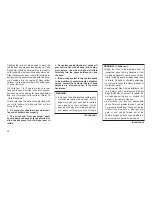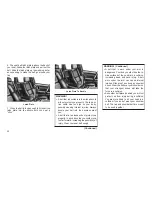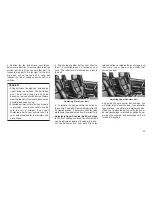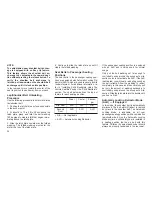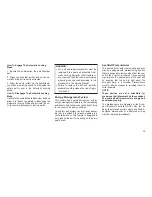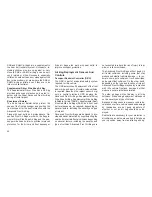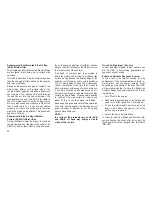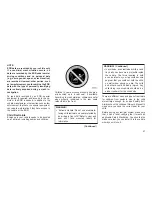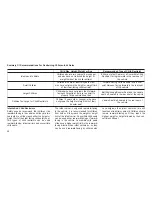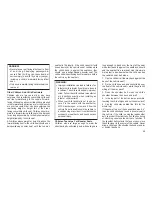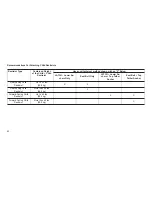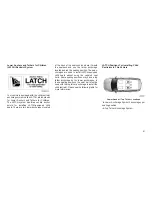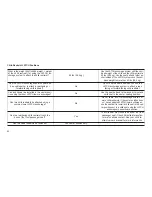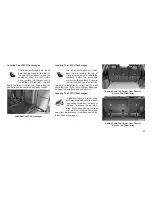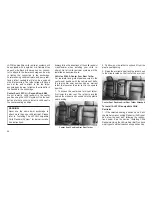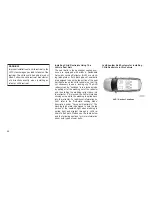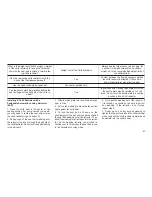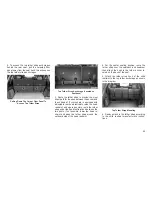
Supplemental Seat-Mounted Side Air Bag
(SAB) Inflator Units
The Supplemental Seat-Mounted Side Air Bags
are designed to activate only in certain side
collisions.
The ORC determines if a side collision requires
the side air bags to inflate, based on the severity
and type of collision.
Based on the severity and type of collision, the
side air bag inflator on the crash side of the
vehicle may be triggered, releasing a quantity of
non-toxic gas. The inflating SAB exits through
the seat seam into the space between the
occupant and the door. The SAB fully inflate in
about 10 milliseconds. The side air bag moves
at a very high speed and with such a high force
that it could injure you if you are not seated
properly, or if items are positioned in the area
where the side air bag inflates. This especially
applies to children.
Supplemental Side Air Bag Inflatable
Curtain (SABIC) Inflator Units
During collisions where the impact is confined
to a particular area of the side of the vehicle, the
ORC may deploy the SABIC air bags depend-
ing on the severity and type of collision. In these
events, the ORC will deploy the SABIC only on
the impact side of the vehicle.
A quantity of non-toxic gas is generated to
inflate the side curtain air bag. The inflating side
curtain air bag pushes the outside edge of the
headliner out of the way and covers the window.
The air bag inflates in about 30 milliseconds
(about one-quarter of the time that it takes to
blink your eyes) with enough force to injure you
if you are not belted and seated properly, or if
items are positioned in the area where the side
curtain air bag inflates. This especially applies
to children. The side curtain air bag is only
about 3-1/2 in (9 cm) thick when it is inflated.
Because air bag sensors estimate deceleration
over time, vehicle speed and damage are not
good indicators of whether or not an air bag
should have deployed.
NOTE:
In a rollover the pretensioners, and/or SAB
and SABIC air bags may deploy on both
sides of the vehicle.
Front And Side Impact Sensors
In front and side impacts, impact sensors can
aid the ORC in determining appropriate re-
sponse to impact events.
Enhanced Accident Response System
In the event of an impact causing air bag
deployment, if the communication network re-
mains intact, and the power remains intact,
depending on the nature of the event the ORC
will determine whether to have the Enhanced
Accident Response System perform the follow-
ing functions:
•
Cut off fuel to the engine.
•
Flash hazard lights as long as the battery has
power or until the ignition key is turned off.
•
Turn on the interior lights, which remain on as
long as the battery has power or until the
ignition key is removed.
•
Unlock the doors automatically.
In order to reset the Enhanced Accident Re-
sponse System functions after an event, the
ignition switch must be changed from IGN ON to
IGN OFF.
44
Summary of Contents for Grand Cherokee SRT 2014
Page 1: ......
Page 3: ......
Page 4: ......
Page 6: ...2...
Page 11: ...7...
Page 68: ...64...
Page 154: ...INSTRUMENT CLUSTER 150...
Page 203: ...Control Setting Suggestions for Various Weather Conditions 199...
Page 204: ...200...
Page 276: ...272...
Page 330: ...326...
Page 331: ...8 MAINTENANCE SCHEDULES MAINTENANCE SCHEDULE 328 327...
Page 332: ...MAINTENANCE SCHEDULE Refer to the Service and Warranty Handbook for maintenance schedules 328...
Page 333: ...9 IF YOU NEED CONSUMER ASSISTANCE IF YOU NEED ASSISTANCE 330 329...
Page 335: ...331...
Page 336: ...332...
Page 337: ...10 INDEX 333...

